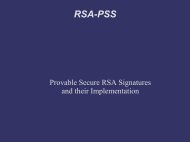RSA-PSS â Provably secure RSA Signatures and their ...
RSA-PSS â Provably secure RSA Signatures and their ...
RSA-PSS â Provably secure RSA Signatures and their ...
You also want an ePaper? Increase the reach of your titles
YUMPU automatically turns print PDFs into web optimized ePapers that Google loves.
In the PKCS st<strong>and</strong>ard, the old <strong>and</strong> new signature schemes are called<strong>RSA</strong>SSA-<strong>PSS</strong> <strong>and</strong> <strong>RSA</strong>SSA-PKCS1-v1 5, the underlying encoding operationsEMSA-<strong>PSS</strong> <strong>and</strong> EMSA-PKCS1-v1 5. These naming conventions will be usedwithin this document. If we refer specifically to the original <strong>PSS</strong> version, wewill call it <strong>PSS</strong>96.3.4 Mask Generation Function<strong>PSS</strong> requires a so-called mask generation function. This is basically like a hashfunction, but with a variable output size. In other contexts, similar functionsare also called key derivation functions. The PKCS #1 v2.1 st<strong>and</strong>ard lists onlyone possible function, MGF1. It is based on an existing hash algorithm <strong>and</strong>just works by using the input plus a four byte counter starting with zero as aninput for the hash function <strong>and</strong> increment the counter to get enough output bitsfrom the hash function. The last output is cut to get the required size. MGF1is mostly equivalent to the key derivation function KDF2, as specified in ISO18033-2 [ISO, 2006].MGF1 has the property that two calls to MGF1 with the same hash function<strong>and</strong> the same input with a different output size would lead to an output identicalat the beginning. For example, if we calculate both MGF1(SHA-256, "hello",10) <strong>and</strong> MGF1(SHA-256, "hello", 20), we get:MGF1(SHA-256, "hello", 10) = da75447e22f9f99e1be0MGF1(SHA-256, "hello", 15) = da75447e22f9f99e1be09a00cf1a07As we see, the first 10 bytes of the second MGF1 output are identical to thefirst MGF1 output.This looks like an unideal cryptographic property of a mask generation function.This has no impact on <strong>PSS</strong> – the only possible scenario where one wouldhave the same input to MGF1 <strong>and</strong> a different output length would be if one usedthe same salt <strong>and</strong> message with a different key size (compare figure 4). So withina proper implementation of <strong>RSA</strong>SSA-<strong>PSS</strong>, the use of MGF1 is just fine. However,if MGF1 is used within other cryptographic constructions, this propertyshould be consider <strong>and</strong> it should be investigated if it causes any problems.3.5 Patents on <strong>PSS</strong>The University of California has filed two patents on <strong>PSS</strong>[Bellare <strong>and</strong> Rogaway, 2001] [Bellare <strong>and</strong> Rogaway, 2006]. During thest<strong>and</strong>ardization process for IEEE P1363a, they claimed that if <strong>PSS</strong> withappendix gets st<strong>and</strong>ardized, they will freely license the patent to anyone doingimplementations of the st<strong>and</strong>ard [Grell <strong>and</strong> University of California, 1999].They would however charge fees for <strong>PSS</strong> with message recovery.Both patents have not been renewed <strong>and</strong> thus #6,266,771 expired on July24, 2009 <strong>and</strong> #7,036,014 expired on April 25, 2010. So currently, <strong>PSS</strong> in any15



